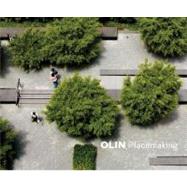
Olin was founded by Laurie Olin in 1976. In addition to Olin, the firm has five partners: Dennis C. McGlade, Robert J. Bedell, Lucinda R. Sanders, Susan K. Weiler, and David A. Rubin. The Olin office is in the historic Public Ledger Building, overlooking Independence Mall in Philadelphia.
John R. Stilgoe, Robert and Lois Orchard Professor in the History of Landscape at Harvard University, is the author of numerous books, including Train Time, Outside Lies Magic, Lifeboat, and Landscapes and Images. The author lives in Philadelphia, PA.
| Introduction | p. 7 |
| The Unstated Goal: Laurie D. Olin, Michael Palmer | p. 10 |
| Bryant Park: New York | p. 22 |
| Bishopsgate: London | p. 32 |
| Vila Olimpica: Barcelona, Spain | p. 42 |
| Robert F. Wagner, Jr. Park: New York | p. 54 |
| The New Garden: Dennis C. McGlade and Kim Tripp | p. 64 |
| J. Paul Getty Center: Los Angeles, California | p. 74 |
| Mission Bay Master Plan: San Francisco, California | p. 88 |
| National Gallery of Art Sculpture Garden: Washington, D.C. | p. 96 |
| Midway Plaisance: Chicago, Illinois | p. 108 |
| Church of Jesus Christ of Latter-Day Saints Conference Center: Salt Lake City, Utah | p. 118 |
| Art and Landscape: Susan K. Weiler and Jenny Holzer | p. 128 |
| Canary Wharf: London | p. 136 |
| Welles Sculpture Garden, Toledo Museum of Art: Toledo, Ohio | p. 146 |
| Massachusetts Institute of Technology: Cambridge, Massachusetts | p. 152 |
| Gap Headquarters: San Francisco, California | p. 160 |
| University of Pennsylvania: Philadelphia, Pennsylvania | p. 170 |
| A Material Realization: Robert J. Bedell and Niall Kirkwood | p. 178 |
| Brancusi Ensemble: Targu-Jiu, Romania | p. 186 |
| Washington Monument: Washington, D.C. | p. 196 |
| Columbus Circle: New York | p. 204 |
| University of British Columbia, University Boulevard Competition: Vancouver, Canada | p. 214 |
| Syracuse Connective Corridor Competition: Syracuse, New York | p. 224 |
| The Spark of Ingenuity: David A. Rubin and Sean Timmons | p. 232 |
| United States Air Force Memorial: Arlington, Virginia | p. 240 |
| Camana Bay: Grand Cayman Island, British West Indies | p. 248 |
| United States Embassy: Berlin, Germany | p. 256 |
| University of California: Berkeley, California | p. 260 |
| The Presidio: San Francisco, California | p. 268 |
| Comcast Center: Philadelphia, Pennsylvania | p. 276 |
| Repositioning: Lucinda R. Sanders and Charles Waldheim | p. 288 |
| Project Credits | p. 298 |
| Biographies | p. 304 |
| Table of Contents provided by Blackwell. All Rights Reserved. |
The New copy of this book will include any supplemental materials advertised. Please check the title of the book to determine if it should include any access cards, study guides, lab manuals, CDs, etc.
The Used, Rental and eBook copies of this book are not guaranteed to include any supplemental materials. Typically, only the book itself is included. This is true even if the title states it includes any access cards, study guides, lab manuals, CDs, etc.
Excerpted from Olin: Placemaking by Dennis C. McGlade, Robert J. Bedell, Lucinda R. Sanders, Susan K. Weiler, Laurie Olin
All rights reserved by the original copyright owners. Excerpts are provided for display purposes only and may not be reproduced, reprinted or distributed without the written permission of the publisher.